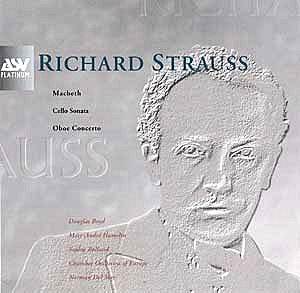Delving into its vaults, ASV has come up with
a fascinating and rewarding disc. The linking of the magnificent,
autumnal Oboe Concerto, full of compositional security and sure-footedness,
with the headstrong, bravado-laden Macbeth and the throw-away
cocksureness of the Cello Sonata is richly rewarding.
Good to see the long playing time, worthy of
note here as the original coupling for the Oboe Concerto (the
Mozart, on CDCOE808) came to a mere 44 mjnutes. Boyd and the COE
evoke the aching quality of the first movement well. Only some
spotlighting of woodwind contributions detracts. The clarinet
at around 3’50 in is suddenly rather too close for comfort. However
the long-breathed lines of the slow movement of this work from
the master’s final period make up for this, weaving a calm spell
over the listener. The chirpy finale is guaranteed to delight.
Certainly there is much competition for this piece (Holliger on
a Philips twofer, 438 733-2, or Schellenberger on DG 429 750-2
spring to mind), but Boyd will not disappoint.
The ten-second gap between tracks 1 and 2 actually
heralds a leap back across 55 years. The symphonic poem Macbeth
is a young man’s bravado writ large Themes are assigned to both
the titular hero and his wife. Norman Del Mar was a noted Strauss
scholar, and his devotion to and knowledge of this score shine
out from every bar. The Danish orchestra plays its heart out for
him, making the act of forgiving the occasional scrappy bit of
string playing an easy one. Both Macbeth and his wife are complex
characters, and the twists and turns of Strauss’s piece reflect
that musically. This music is utterly Straussian through and through.
The climax is as exciting as they come (around 13 minutes in),
the ending marvellously tender.
The same sort of musicianly cockiness informs
the writing in the Cello Sonata. It will come as no shock for
the informed reader to discover that Hamelin has no problems whatsoever
with the tricky piano part. He does, in fact, find much fertile
ground here, and there are many felicitous touches to delight
in. This is not to demean the achievement of Sophie Rolland, who
despatches the cello part with aplomb. The ‘slow’ movement (Andante
ma non troppo) is, rightly, the expressive highlight of the Sonata,
the Allegro vivo finale returning to the swagger of the opening.
As an alternative coupling for the Cello Sonata, Anne Gastinel
and another big-name pianist Pierre-Laurent Aimard, add the Rachmaninov
Cello Sonata on Auvidis V4692. Really one should have both, though.
As a whole, this disc makes for informative and
rewarding listening.
Colin Clarke

![]() Douglas Boyd (oboe);
Chamber Orchestra of Europe/Paavo Berglund (Oboe Concerto); Aarhus Symphony
Orchestra/Norman Del Mar (Macbeth); Sophie Rolland (cello); Marc-André
Hamelin (piano).
Douglas Boyd (oboe);
Chamber Orchestra of Europe/Paavo Berglund (Oboe Concerto); Aarhus Symphony
Orchestra/Norman Del Mar (Macbeth); Sophie Rolland (cello); Marc-André
Hamelin (piano).![]() ASV PLATINUM PLT8519
[70’07]
ASV PLATINUM PLT8519
[70’07]